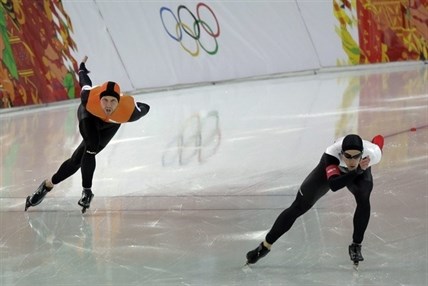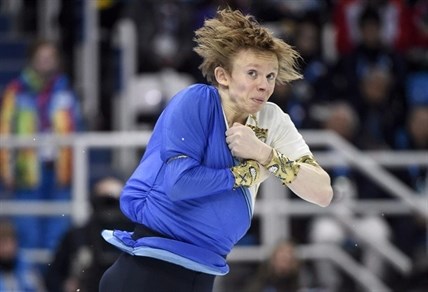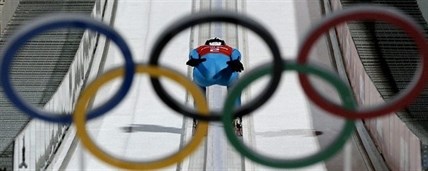
Image Credit: The Canadian Press
February 12, 2014 - 3:55 PM
THE CANADIAN PRESS'S OLYMPIC REPORT CARD
SOCHI, Russia - On a day with few medal prospects, speedskater Denny Morrison came through for Canada with an assist from Gilmore Junio at the Winter Olympics on Wednesday.
Morrison, of Fort St. John, B.C., won silver in the 1,000 metres for Canada's lone medal of the day.
Morrison fell in the distance at the Canadian trials and didn't qualify to race it in Sochi, Russia. Teammate Junio, of Calgary, stepped aside so Morrison could compete in it.
The goal for Canada in Sochi is to win the overall medal count. The Canadian team was tied for second at 10 medals with the Netherlands, two behind Norway.
The good:
— Morrison's silver and Junio's generosity was a feel-good success story for Canada.
— The Canadian women's hockey team edged the U.S. 3-2 in to conclude the preliminary round 3-0.
— The Jennifer Jones curling team from Winnipeg stayed unbeaten at 3-0. The men's curling team skipped by Brad Jacobs bounced back from two losses in a row for a win against Russia and was 2-2.
The bad:
— Canada's lugers finished just off the podium in fourth for the second time in as many days. The doubles team of Justin Snith and Tristan Walker of Calgary will get another crack at a medal in Thursday's team relay.
— No medal in pairs figure skating. Meagan Duhamel of Lively, Ont., and Eric Radford of Balmerton, Ont., were fifth.
— No Canadian women qualified for the final in snowboard halfpipe.
Canada's grade: C
Ones to watch Thursday: The Canadian men's hockey team opens the preliminary round against Norway. Calgarians Alex Gough, Sam Edney and the doubles team of Snith and Walker will try to claim a medal in the team event. Speedskater Christine Nesbitt attempts to defend her title in the 1,000 metres. Marianne St. Gelais of St. Felicien, Que., races the 500 metres in short track.
QUAD HAS BEEN MASTERED: IS THE QUINT NEXT?

Image Credit: The Canadian Press
It has been more than 25 years since Canadian figure skating legend Kurt Browning landed the first quadruple jump in competition.
Now the jump is essentially mandatory for elite men's competitors. It begs the question: if skaters can complete four revolutions in the air — is it possible to add a fifth?
The idea of a quintuple jump even being a possibility draws mixed opinions from the Canadian figure skating community. Some think we'll see it down the road, others feel there's a chance it might be possible and a few laughed at the mere suggestion it could ever happen.
So will we ever see a "quint" landed in competition one day?
"I think so. I do, I think so," said Joanne McLeod, who coaches Canadian figure skater Kevin Reynolds. "You know, I would think in the next 20 years I think somebody will be able to do it."
Many skaters who have quads in their repertoires do toe loops, where the same back outside edge of the skate is used for the takeoff and the landing.
The Salchow is also performed regularly on the circuit. With that jump, the skater takes off from the back inside edge of one skate and lands backward on the outside edge of the opposite skate.
"You look at 10-15 years ago and you didn't see a lot of quads," Skate Canada high-performance director Mike Slipchuk said in a recent interview. "And now quads are all over the place. You know what, anything is possible. It's like any sport — the levels are being pushed."
It's tempting to get carried away by thinking about the possibilities. It's also easy to forget there is still work to be done on the quad.
According to the International Skating Union, there are three quad jumps — the quad flip, quad loop and quad Axel — that have not been successfully landed in competition. Quad flips and quad loops have been attempted, but they were not recognized as the skater either didn't land cleanly or under-rotated.
McLeod said figure skaters are always pushing forward with advancements in speed, fitness, technology and coaching.
"I mean it's like golf — the physique of the golfer changed when Tiger (Woods) took the club," she said. "They were more conditioned, a little taller, a little more rotation in the waist. You look at the NHL. The players are a little younger, a little more cardio-friendly. So the sport, having the quad, it requires a quick twitch. Like a basketball player and how quick they can deke.
"So there's a quickness that you need to have with your limbs coming into your centre of gravity. You have to have the right technique, you have to work with a good technician and you can't just learn it at the end of the game. You have to have the foundation so that it's going to give you that."
While practising Wednesday for Thursday's men's short program at the Sochi Olympics, Canadian skater Kevin Reynolds nailed a whopping 12 quad jumps. There was a time when that would have been unthinkable but Reynolds calls it "normal."
Slipchuk, a former skater himself, said he sees quads and triple Axels now at the junior level. He wouldn't rule out seeing a quint jump at some point in the future.
"Who knows how soon?" he said. "There are still a few quad jumps that people haven't done. But someone's always going to look for an edge, and that's an edge. The guys do the quads right now and they look like triples. They look easy.
"So I think when you look at any sport, it's just the levels are being pushed. So we'll see, who knows?"
Others weren't so sure, including Browning, who hit a quad toe loop at the 1988 world championships to become the first skater to have the jump officially ratified, according to the ISU.
He joked that for a quint to be possible, a skater "wouldn't have shoulders and hips."
"They'd just be like a string with skates on," he said with a laugh. "Maybe there will be a sighting of a Sasquatch at the same time that there's a sighting of a quint. And maybe it'll be real and ratified by video somewhere.
"But I just don't think the quint will ever be a consistent thing like it is the quad. There's just too much gravity."
A quint would require a skater to either propel themselves even higher in the air or wrap themselves up even tighter so that they can spin faster and complete that fifth revolution.
Advancements in technology and in strength and conditioning may help in the future. Or maybe an athlete with perfect proportions will emerge on the figure skating scene — like sprinter Usain Bolt did in track or UFC light-heavyweight champion Jon (Bones) Jones in mixed martial arts.
McLeod said every once in a while, a phenom comes around who changes the game for everyone. She points to Japanese skater Midori Ito — who she called "superhuman" — for her ability to land triple Axels in the late 1980s.
"She was throwing them out like flipping pancakes on the griddle," McLeod said. "And she still had air time and she wasn't even tight. But you look at her body and she's got very, very strong legs. Her centre of gravity was low to the ground. Again, it might take that type of a (special body)."
Even if a skater had the vertical jumping ability, the biggest challenge would likely be keeping the arms folded in tight to the body so that spin speed could be maximized.
Scott Oser, an associate physics professor at the University of British Columbia, said it would take incredible strength to fight off the powerful centrifugal force.
"If you fail to do that, you lose," he said. "As soon as your arm gets extended, it's going to slow down your motion. In physics terms, we say that you've increased your moment of inertia. You just cannot maintain the same rotational speed."
Oser added he felt the quint was still a possibility in principle, but very unlikely to be attempted in competition.
"This is really pushing the limits of endurance for everything," he said. "I think it's really at the edge of human capacity. If you are going to do a jump in a competition, you're not going to do that jump unless you have practised it and can land it reliably."
Clearly even landing such a jump would be a magical feat. Doing so in a graceful manner borders on impossible.
"The risk of injury I think would be very high and I don't know what the limit of what our bodies would be able to take at this point," said Reynolds, who is known for his quad-heavy program. "Maybe in a harness or something it would be fine but trying it out on ourselves I think would be very dangerous."
Ice dancer Scott Moir predicted it would be a long time before a quint is landed in competition, but added similar barriers have been broken in other sports.
"Nobody ever thought anybody would run a four-minute mile, nobody ever thought anybody would run a 9.7 in the 100 metres, you'd have to think that our kids' kids might be doing quints," he said. "But I think that's a long way away. Watching someone do a quad is mind-boggling still for me."
When it comes to the quint, perhaps Oser summed it up best.
"The way I would put it is, I think it's humanly possible. I think that I will never see it done in competition during my lifetime. And I'm not that old."
— With files from Canadian Press reporter Cassandra Szklarski and The Associated Press.
---
Follow @GregoryStrongCP on Twitter
ONLINE OFFERING TRANSFORM OLYMPIC EXPERIENCE

Image Credit: The Canadian Press
The Sochi games are the first Olympics worldwide where more hours of video are available online than on television, rapidly transforming the way people experience the event.
NBC said Wednesday that more than 30 million people in the United States have visited its Olympics websites, up 54 per cent from Vancouver in 2010. NBC is streaming all of the Olympic competition live online, along with other offerings like the "Gold Zone" show that rapidly sends viewers to different venues.
Building on a trend first noticed during the London summer games two years ago, NBC is finding all of the extra content helps instead of hurts its prime-time broadcast.
"The more devices people use to view the Olympics on, the more they watch," said Alan Wurtzel, NBC's top researcher. "A rising tide lifts all boats."
PRIME TIME: For the opening ceremony and first four nights of competition, NBC averaged 25.9 million viewers in the U.S., a level that NBC Sports Group Chairman Mark Lazarus said has "exceeded our expectations." That compares to 26.4 million in Vancouver, where the time zone enabled NBC to air many events live. In Italy in 2006, viewership for the first four nights was 21.6 million. The same trend that helps Super Bowl, Grammy and Golden Globe ratings is at play: popular events that drive social media conversation are doing well. "Viewers want event programming, and there's no bigger event every two years than the Olympics," Lazarus said.
WORLDWIDE: More hours are being broadcast globally from Sochi (more than 88,000) than for any other Winter Olympics, the International Olympic Committee said. There were 57,000 hours of winter competition aired from Vancouver, across all platforms. Sochi competition is being seen on more than 300 TV stations worldwide, up from 215 in Vancouver, the IOC said. With no international agency that tracks viewership like the Nielsen company in the United States, the IOC has only anecdotal knowledge of viewing patterns. For example, an estimated 10.9 million people watched speedskating live Monday in South Korea, more than any other event during the last three winter games.
TWEETS: Twitter said one million tweets mentioned "Olympics" or "#Olympics" during the Vancouver games four years ago. This year, there have been more than two million tweets with either of those citations already. American snowboarder Jamie Anderson had 12,999 followers on Feb. 6, and 41,745 followers six days later. During the same period, Twitter said snowboarder Sage Kotsenburg increased his followers from 10,456 to 60,550. Kotsenburg and Anderson won gold medals in men's and women's slopestyle snowboarding over the weekend.
MULTI-DEVICES: NBC polled a panel of 300 Olympics viewers and found that about two-thirds who watched on TV also followed the games on some other device, most commonly a smartphone. Fully one-quarter of those consumers said they are following the games on a device they've never used for that purpose before.
SPOILERS: The idea of people purposely avoiding knowledge of Olympic results so they can be surprised by the tape-delayed broadcast is rapidly becoming a thing of the past. Nearly 600,000 people watched Shaun White's halfpipe runs online Tuesday afternoon, NBC said. Wurtzel said that only 15 per cent of Olympics viewers said that knowing the results made them less interested in the prime-time broadcast, and there's evidence that many people who watch online come back to see how it looks on TV later that night. "It's still an event, whether you know the results or not," said Brad Adgate, an analyst from Horizon Media.
CURLING: More than 1.2 million people watched matches on CNBC Monday. "Curling is almost unstoppable," Lazarus said.
DIGITAL: Besides the "Gold Zone," a daily ice skating show with Olympic gold medal winner Sarah Hughes is a popular offering online for NBC. The network has also highlighted particularly interesting video clips, the type that might not be shown on television, like the Russian police choir singing "Get Lucky" or a coach's act of sportsmanship in replacing a competitor's broken ski. More than two million people have checked out a clip where a Russian speedskater unzips her uniform after her race, only quickly to zip it up again when she realizes she's wearing nothing underneath, NBC said.
"We love television," Wurtzel said. "But the future is not just about television. It's about television complemented with all of the other platforms that we have."
___
David Bauder can be reached at dbauder@ap.org or on Twitter@dbauder. His work can be found at http://bigstory.ap.org/content/david-bauder.
MEDAL COUNT:

Image Credit: Wikipedia
News from © The Canadian Press, 2014